Text Mining for Consumers’ Sentiment Tendency and Strategies for Promoting Cross-Border E-Commerce Marketing Using Consumers’ Online Review Data
Abstract
1. Introduction
2. Related Research
2.1. Information Asymmetry Theory, Signaling Theory, and Online Review Research
2.2. Reflections on the Integration of 4P and 4C Marketing Theories
2.3. Research on Cross-Border E-Commerce Strategies
3. Research Design
3.1. Research Framework
3.2. Model Introduction
3.2.1. LDA Model
3.2.2. LSTM Model
3.3. Data Source
4. Empirical Analysis
4.1. Data Processing
4.2. Social Network Analysis of Negative Review Concerns
4.2.1. Construction of Co-Occurrence Network for Negative Review Concerns
4.2.2. Network Centrality Analysis
4.3. Topic Mining Based on LDA
4.3.1. Optimization of the Number of Topics
4.3.2. Analysis of Topic Mining Results
4.4. Sentiment Classification Model Based on LSTM
4.4.1. Modeling Process
4.4.2. Model Evaluation Indicators
4.4.3. Analysis of Sentiment Classification Results
4.5. The Evolution Trend of Topic Sentiment Based on Time Series
4.5.1. Trend of Thematic Sentiment Changes over the Years
4.5.2. Trend of Thematic Sentiment Changes During and After the Pandemic
5. Conclusions
Author Contributions
Funding
Institutional Review Board Statement
Informed Consent Statement
Data Availability Statement
Conflicts of Interest
References
- Fathy, E.A.; Salem, I.E.; Zidan, H.A.Y.; Abdien, M.K. From plate to post: How foodstagramming enriches tourist satisfaction and creates memorable experiences in culinary tourism. Curr. Issues Tour. 2024, 1–20. [Google Scholar] [CrossRef]
- Hofstede, G. Culture’s Consequences: International Differences in Work-Related Values; Sage Publications: Thousand Oaks, CA, USA, 1984. [Google Scholar]
- Elshaer, I.A.; Azazz, A.; Fayyad, S.; Mohamed, S.A.; Fouad, A.M.; Fathy, E.A. From Data to Delight: Leveraging Social Customer Relationship Management to Elevate Customer Satisfaction and Market Effectiveness. Information 2025, 16, 9. [Google Scholar] [CrossRef]
- Wang, X.; Guo, J.; Wu, Y.; Liu, N. Emotion as signal of product quality: Its effect on purchase decision based on online customer reviews. Internet Res. 2020, 30, 463–485. [Google Scholar] [CrossRef]
- Choi, H.S.; Leon, S. An empirical investigation of online review helpfulness: A big data perspective. Decis. Support Syst. 2020, 139, 113403. [Google Scholar] [CrossRef]
- Hong, H.; Xu, D.; Wang, G.A.; Fan, W. Understanding the determinants of online review helpfulness: A meta-analytic investigation. Decis. Support Syst. 2017, 102, 1–11. [Google Scholar] [CrossRef]
- Ruijuan, W.; Peiyu, L.; Yan, L. The Effect of Image Number in Online Consumer Reviews on Review Helpfulness—An Empirical Study Based on Negative Reviews. Manag. Rev. 2022, 34, 157. [Google Scholar]
- Yan, H.; Liao, Q.; Xiong, H. Emotional or non-emotional? The impact of emojis on the usefulness of online restaurant reviews. Tour Trib 2024, 39, 145–160. [Google Scholar]
- Zhu, Z.; Fang, X.; Shan, M. The effect of language style on consumers’ perceived usefulness of online reviews: From the perspective of regulatory focus. Nankai Bus. Rev. 2024, 27, 234–246. [Google Scholar]
- Kong, J.; Lou, C. Do cultural orientations moderate the effect of online review features on review helpfulness? A case study of online movie reviews. J. Retail. Consum. Serv. 2023, 73, 103374. [Google Scholar] [CrossRef]
- Park, J.; Park, H. Understanding the Impact of Inconsistency on the Helpfulness of Online Reviews. J. Theor. Appl. Electron. Commer. Res. 2025, 20, 80. [Google Scholar] [CrossRef]
- Guo, L.; Li, J. Impact of Consumers’ Perception of Crisis Risks on the Effect of Online Reviews. J. Northeast. Univ. (Nat. Sci.) 2022, 43, 1662. [Google Scholar]
- Flavián, C.; Akdim, K.; Casaló, L.V. Effects of voice assistant recommendations on consumer behavior. Psychol. Mark. 2023, 40, 328–346. [Google Scholar] [CrossRef]
- Riswanto, A.L.; Ha, S.; Lee, S.; Kwon, M. Online Reviews Meet Visual Attention: A Study on Consumer Patterns in Advertising, Analyzing Customer Satisfaction, Visual Engagement, and Purchase Intention. J. Theor. Appl. Electron. Commer. Res. 2024, 19, 3102–3122. [Google Scholar] [CrossRef]
- Wang, B.; Zhao, Q.; Zhang, Z.; Xu, P.; Tian, X.; Jin, P. Understanding the Heterogeneity and Dynamics of Factors Influencing Tourist Sentiment with Online Reviews. J. Theor. Appl. Electron. Commer. Res. 2025, 20, 22. [Google Scholar] [CrossRef]
- Zhang, C.; Liu, Y.; Zhao, B.; Chai, J.; Jiang, F. Research on destination image mining of “tang culture” based on online text sentiment analysis. China J. Econom. 2023, 3, 387–407. [Google Scholar]
- Cheng, F.M.; Wang, J.; Chen, C.; Hu, G.R.; Cao, Z.J. Product design improvement method driven by online product reviews. Sci. Rep. 2025, 15, 10252. [Google Scholar] [CrossRef]
- McCarthy, E.J.; Shapiro, S.J.; Perreault, W.D. Basic Marketing; Irwin-Dorsey: Toronto, ON, Canada, 1979. [Google Scholar]
- Yu, Y.; Suteeca, R. A Study of Factors Affecting the Free Trade of Thai Cocoa Products in China’s E-commerce Market of Hill Tribe Cocoa Cof Co., Ltd. In Proceedings of the 2024 Joint International Conference on Digital Arts, Media and Technology with ECTI Northern Section Conference on Electrical, Electronics, Computer and Telecommunications Engineering (ECTI DAMT & NCON), Chiang-mai, Thailand, 31 January 2024; IEEE: New York, NY, USA, 2024; pp. 336–341. [Google Scholar]
- Lan, Y.Y.; Qu, X.T. Research on B2C E-commerce Marketing Strategies Using Jingdong Mall as an Example. In Proceedings of the 3rd Annual International Conference on Management, Economics and Social Development (ICMESD 17); Atlantis Press: Bedford Park, IL, USA, 2017; pp. 557–563. [Google Scholar]
- Li, L.; Mao, Z.; Ren, Y. E-commerce Precision Marketing Based on the Advantages of Big Data Technology. For. Chem. Rev. 2021, 70–79. [Google Scholar]
- Lauterborn, B. New marketing litany: Four Ps passé: C-words take over. Advert. Age 1990, 41, 26. [Google Scholar]
- He, Y.; Li, J. On Marketing Modes of ICBEC Based on 4C Principles-A Case Study of Mia. In Proceedings of the 2017 International Conference on Applied Mathematics, Modelling and Statistics Application (AMMSA 2017); Atlantis Press: Bedford Park, IL, USA, 2017; pp. 270–274. [Google Scholar]
- Lei, S. Online Marketing Factors Influencing Shopping Decisions Through Cross-Border E-commerce Platform. In Proceedings of the International Academic Multidisciplinary Research Conference in Geneva 2022, Geneva, Switzerland, 3–6 October 2022; pp. 25–29. [Google Scholar]
- Maidar, U.; Ra, M.; Yoo, D. A Cross-Product Analysis of Earphone Reviews Using Contextual Topic Modeling and Association Rule Mining. J. Theor. Appl. Electron. Commer. Res. 2024, 19, 3498–3519. [Google Scholar] [CrossRef]
- Goldman, S.P.; van Herk, H.; Verhagen, T.; Weltevreden, J.W. Strategic orientations and digital marketing tactics in cross-border e-commerce: Comparing developed and emerging markets. Int. Small Bus. J. 2021, 39, 350–371. [Google Scholar] [CrossRef]
- Feng, D.; Jun, C.; Chao, C.; Jia-zhen, H. Study on cross-border e-commerce competitive differentiation strategy. Oper. Res. Manag. Sci. 2019, 28, 33–40. [Google Scholar]
- Cai, Y.; Liu, X. AI-Driven Social Media E-commerce Advertising: A Cross-Cultural Communication Study from the Perspective of Yiwu’s Trade and Commerce. Sociol. Philos. Psychol. 2024, 1, 20–32. [Google Scholar] [CrossRef]
- Xiong, J. Research on the Construction Strategy of Independent Stations for Cross-border E-commerce Enterprises. J. Jiaozuo Univ. 2021, 35, 84–87. [Google Scholar]
- Li, X.; Ke, Q. Strategic Research on the Development of China-ASEAN Cross-border E-commerce under the Background of the Belt and Road Initiative. Pract. Foreign Econ. Relat. Trade 2019, 9, 33–36. [Google Scholar]
- Liu, Y. Optimization of Export Marketing Strategies for Cross-border E-commerce under the Belt and Road Initiative. Pract. Foreign Econ. Relat. Trade 2019, 2, 36–39. [Google Scholar]
- Wu, Z.; Zhang, S. Research on the Strategies of China’s Agricultural Products Cross-border E-commerce under the Background of the Belt and Road Initiative. Bus. Econ. 2021, 7, 79–81. [Google Scholar]
- Chen, W.H.; Lin, Y.C.; Bag, A.; Chen, C.L. Influence factors of small and medium-sized enterprises and micro-enterprises in the cross-border e-commerce platforms. J. Theor. Appl. Electron. Commer. Res. 2023, 18, 416–440. [Google Scholar] [CrossRef]
- Wang, G.; Zhang, Z.; Li, S.; Shin, C. Research on the influencing factors of sustainable supply chain development of agri-food products based on cross-border live-streaming e-commerce in China. Foods 2023, 12, 3323. [Google Scholar] [CrossRef]
- Fan, M.; Tang, Z.; Qalati, S.A.; Tajeddini, K.; Mao, Q.; Bux, A. Cross-Border e-commerce brand internationalization: An online review evaluation based on Kano model. Sustainability 2022, 14, 13127. [Google Scholar] [CrossRef]
- Jiang, H.; Cai, J.; Lin, Y.; Wang, Q. Understanding the effect of TikTok marketing on user purchase behavior: A mixed-methods approach. Electron. Commer. Res. 2024, 1–36. [Google Scholar] [CrossRef]
- Han, L.; Han, X. Improving the service quality of cross-border e-commerce: How to understand online consumer reviews from a cultural differences perspective. Front. Psychol. 2023, 14, 1137318. [Google Scholar] [CrossRef]
- Giuffrida, M.; Mangiaracina, R.; Perego, A.; Tumino, A. Cross-border B2C e-commerce to China: An evaluation of different logistics solutions under uncertainty. Int. J. Phys. Distrib. Logist. Manag. 2020, 50, 355–378. [Google Scholar] [CrossRef]
- Zhang, Y.; Huang, H. Unraveling how poor logistics service quality of cross-border E-commerce influences customer complaints based on text mining and association analysis. J. Retail. Consum. Serv. 2025, 84, 104237. [Google Scholar] [CrossRef]
- Huang, L.; Ma, L. A protective buffer or a double-edged sword? Investigating the effect of “parasocial guanxi” on consumers’ complaint intention in live streaming commerce. Comput. Hum. Behav. 2024, 151, 108022. [Google Scholar] [CrossRef]
- Guo, X.; Ma, S.; Zhang, H. Does cross-border e-commerce improve China’s imported product quality?—A quasi-natural experiment based on the establishment of cross-border e-commerce comprehensive pilot zones. J. Int. Trade Econ. Dev. 2024, 1–24. [Google Scholar] [CrossRef]
- Duan, W.; Gu, B.; Whinston, A.B. Do online reviews matter?—An empirical investigation of panel data. Decis. Support Syst. 2008, 45, 1007–1016. [Google Scholar] [CrossRef]
- Ramanathan, U.; Ramanathan, R. Investigating the impact of resource capabilities on customer loyalty: A structural equation approach for the UK hotels using online ratings. J. Serv. Mark. 2013, 27, 404–415. [Google Scholar] [CrossRef]
- Ghasemaghaei, M.; Eslami, S.P.; Deal, K.; Hassanein, K. Reviews’ length and sentiment as correlates of online reviews’ ratings. Internet Res. 2018, 28, 544–563. [Google Scholar] [CrossRef]
- Zhou, R.; Zhu, Y.; Zheng, R.; Zhou, J. Differences of consumer reviews and consumer satisfaction on cross-border e-commerce platforms: A text mining analysis based on cross-cultural perspective. J. Organ. Comput. Electron. Commer. 2025, 1–23. [Google Scholar] [CrossRef]
- Huang, Y.; He, Z.; Lv, H.; Min, J. Research on Mining Negative Online Reviews on E-commerce Platforms Based on Social Network Analysis and LDA Model. In Intelligent Management of Data and Information in Decision Making: Proceedings of the 16th FLINS Conference on Computational Intelligence in Decision and Control & the 19th ISKE Conference on Intelligence Systems and Knowledge Engineering (FLINS-ISKE 2024); World Scientific Publishing: Singapore, 2024; pp. 177–185. [Google Scholar]
- Blei, D.M.; Ng, A.Y.; Jordan, M.I. Latent dirichlet allocation. J. Mach. Learn. Res. 2003, 3, 993–1022. [Google Scholar]
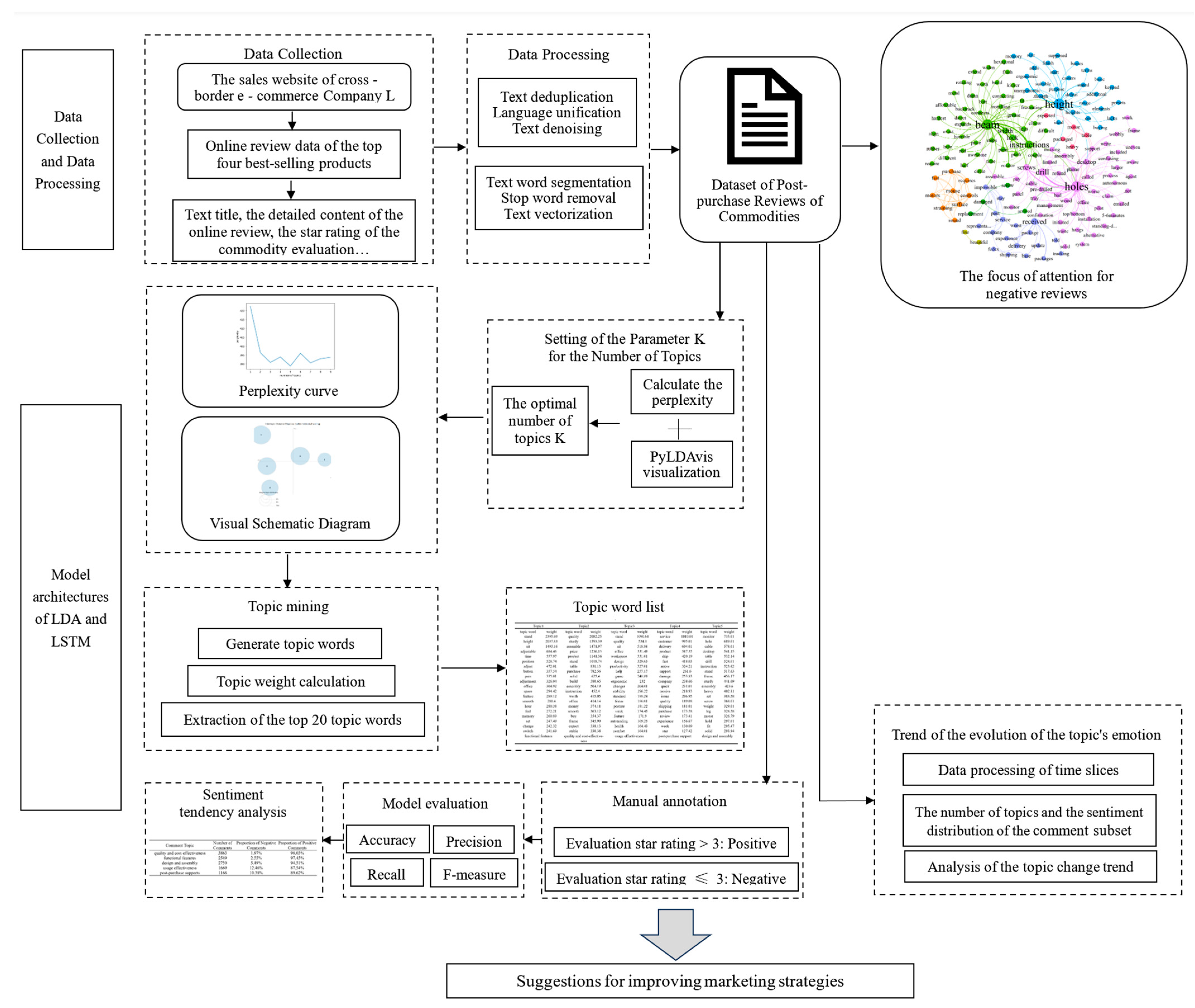
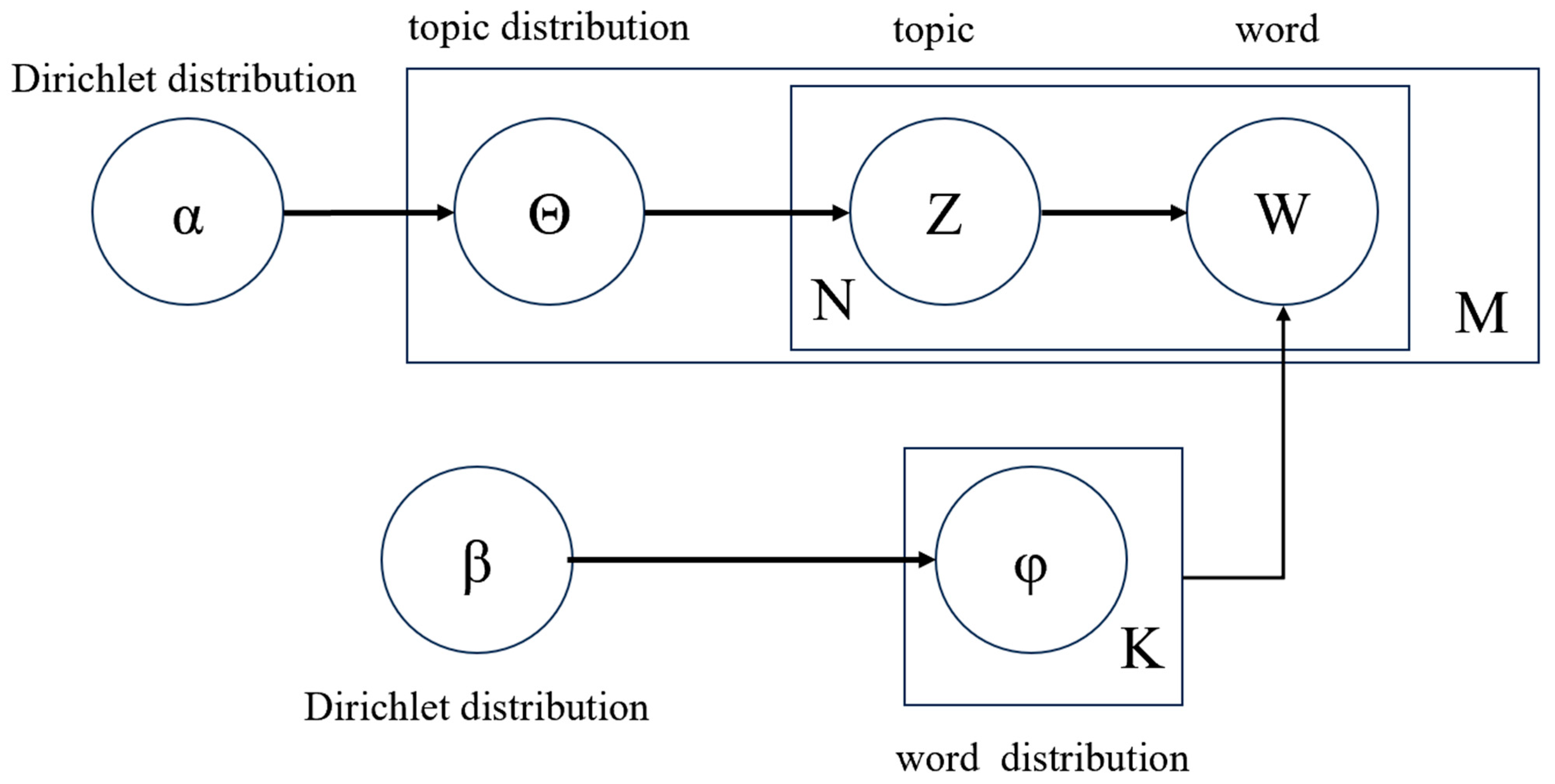
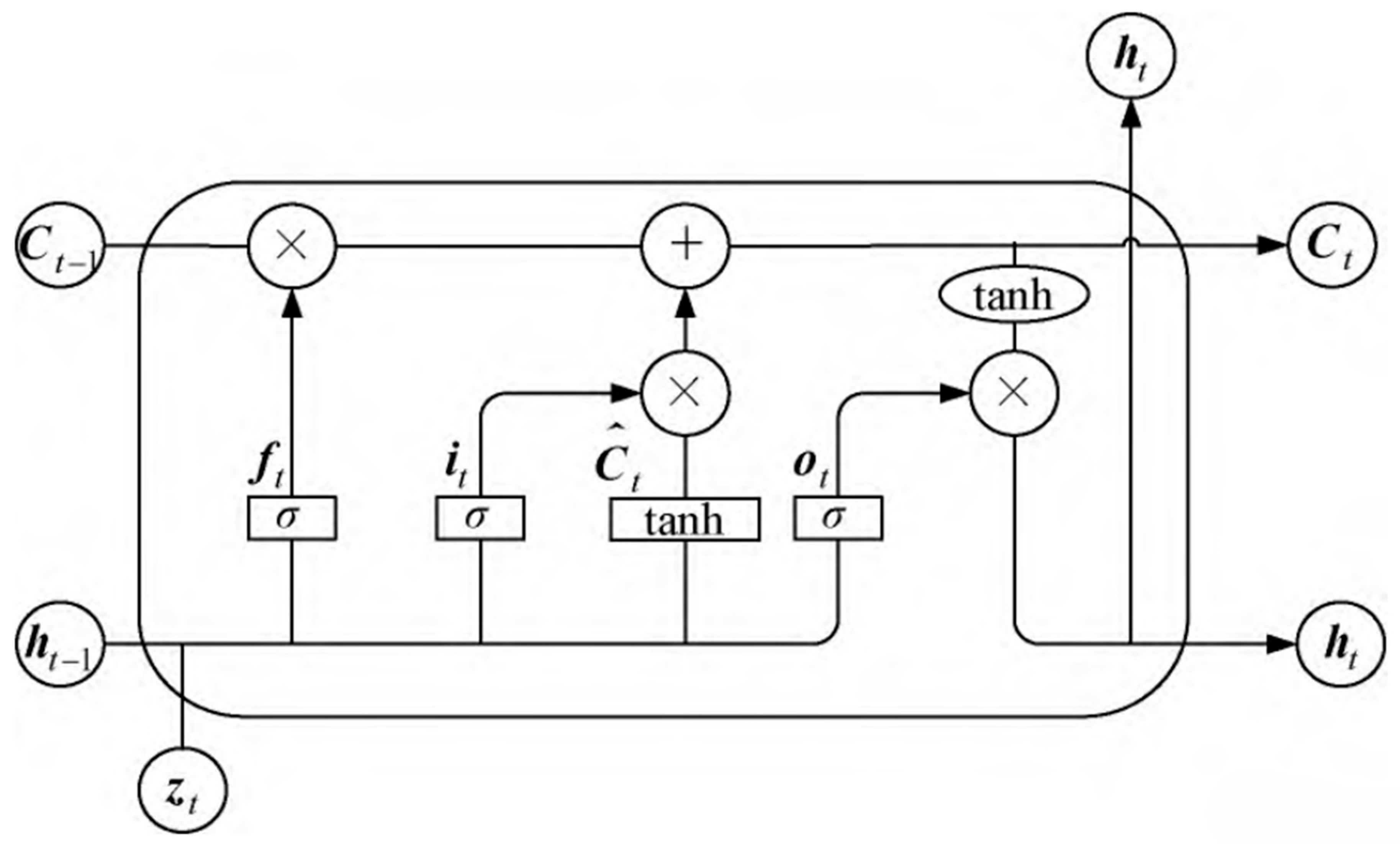
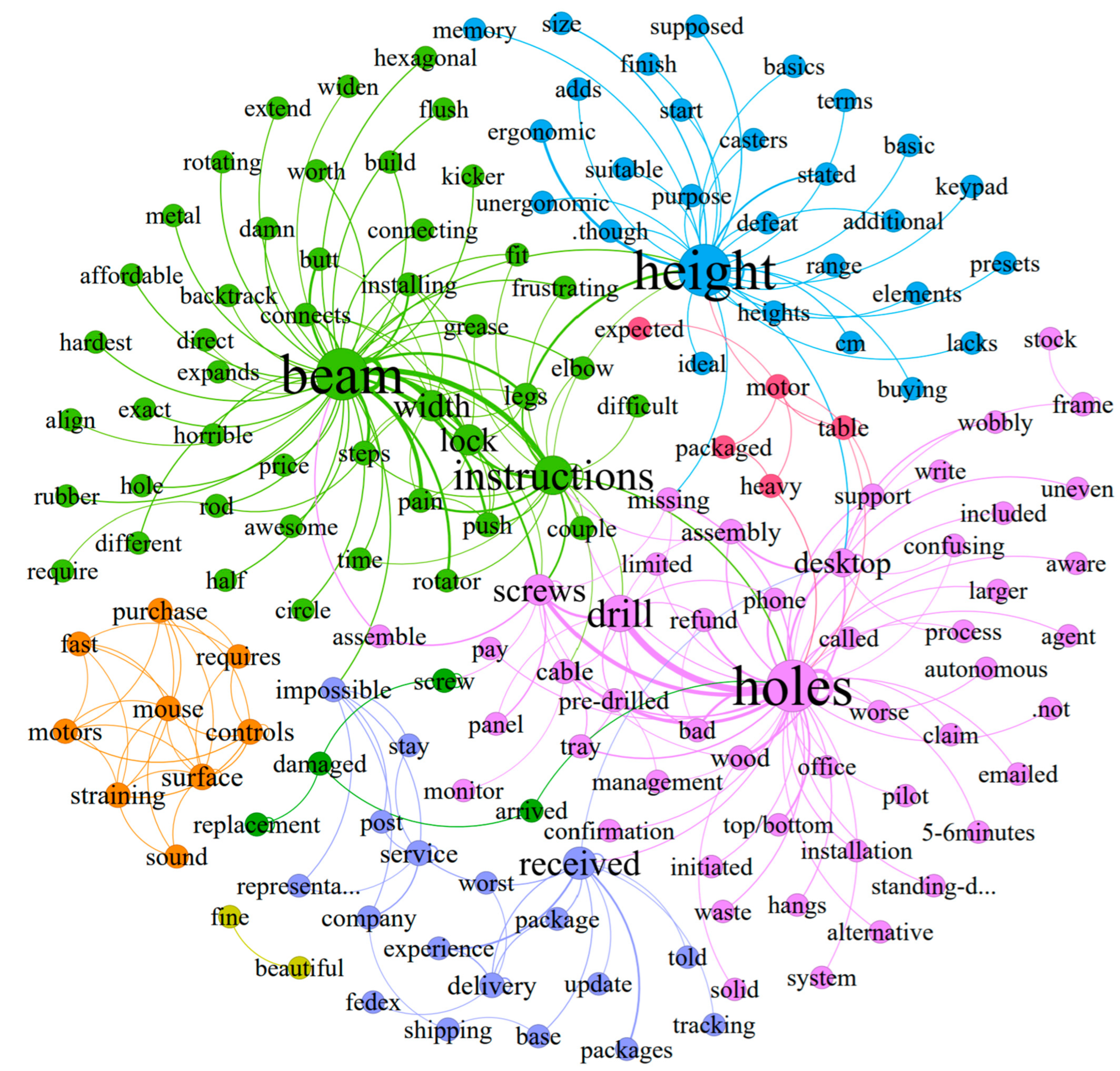
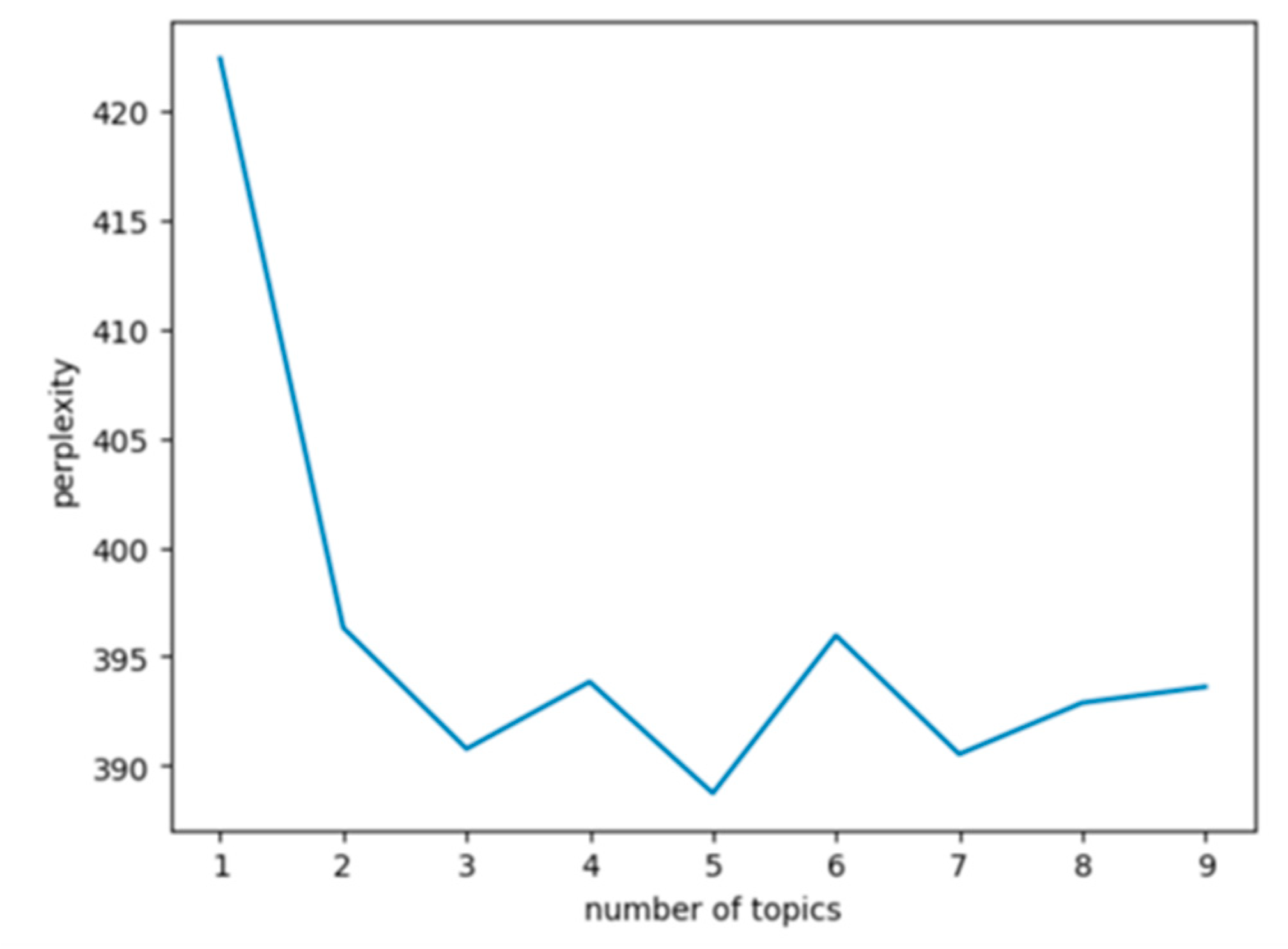
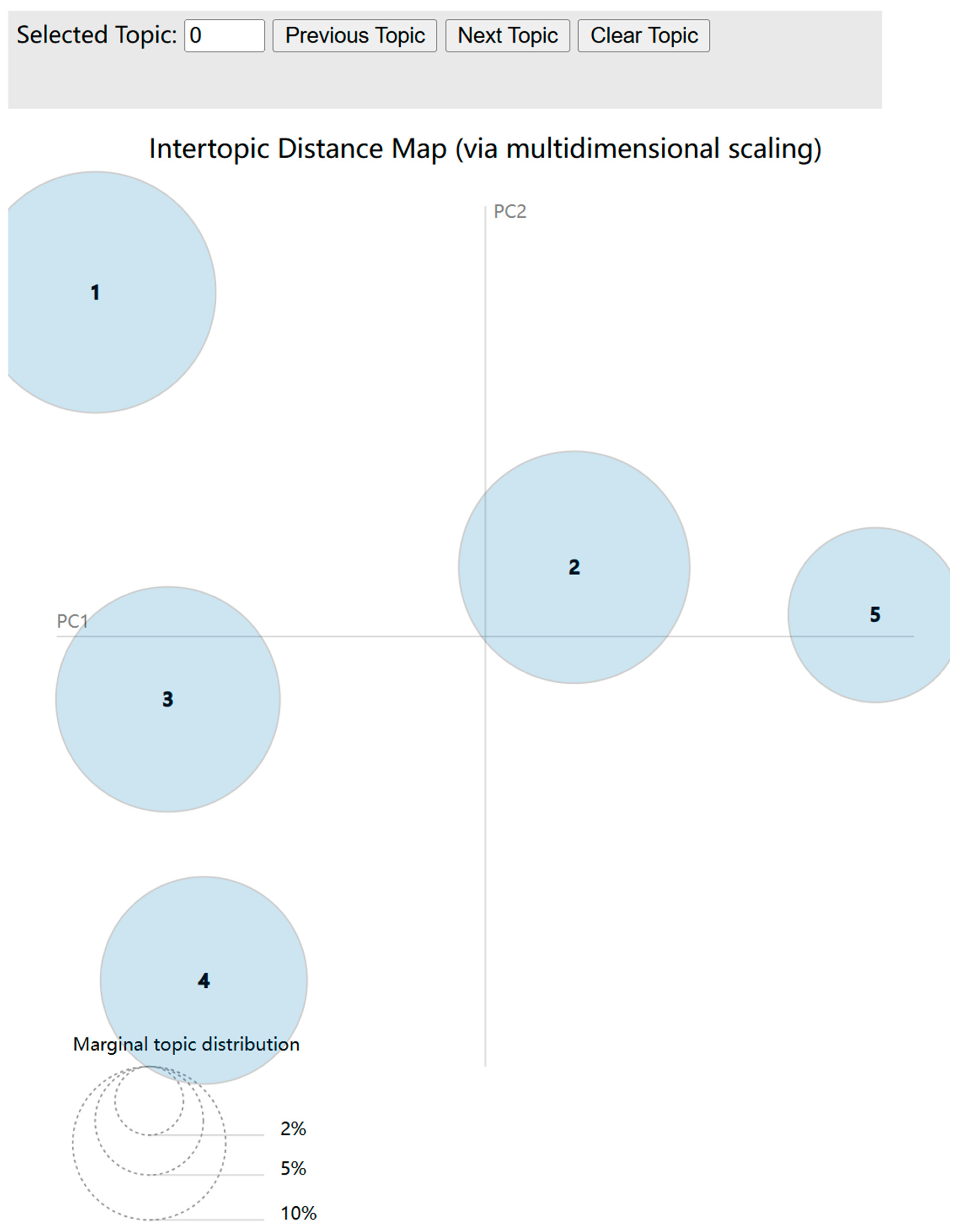
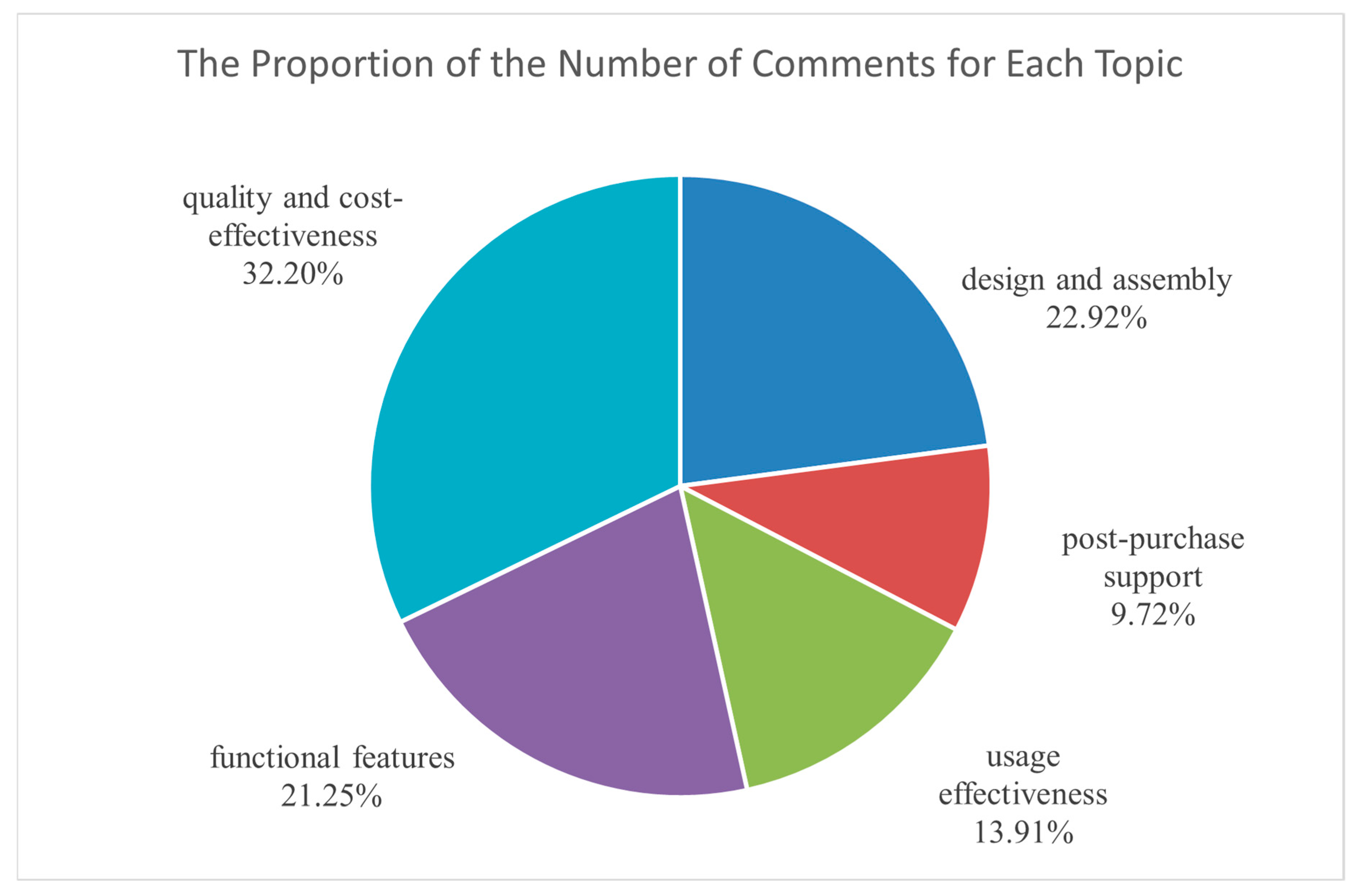
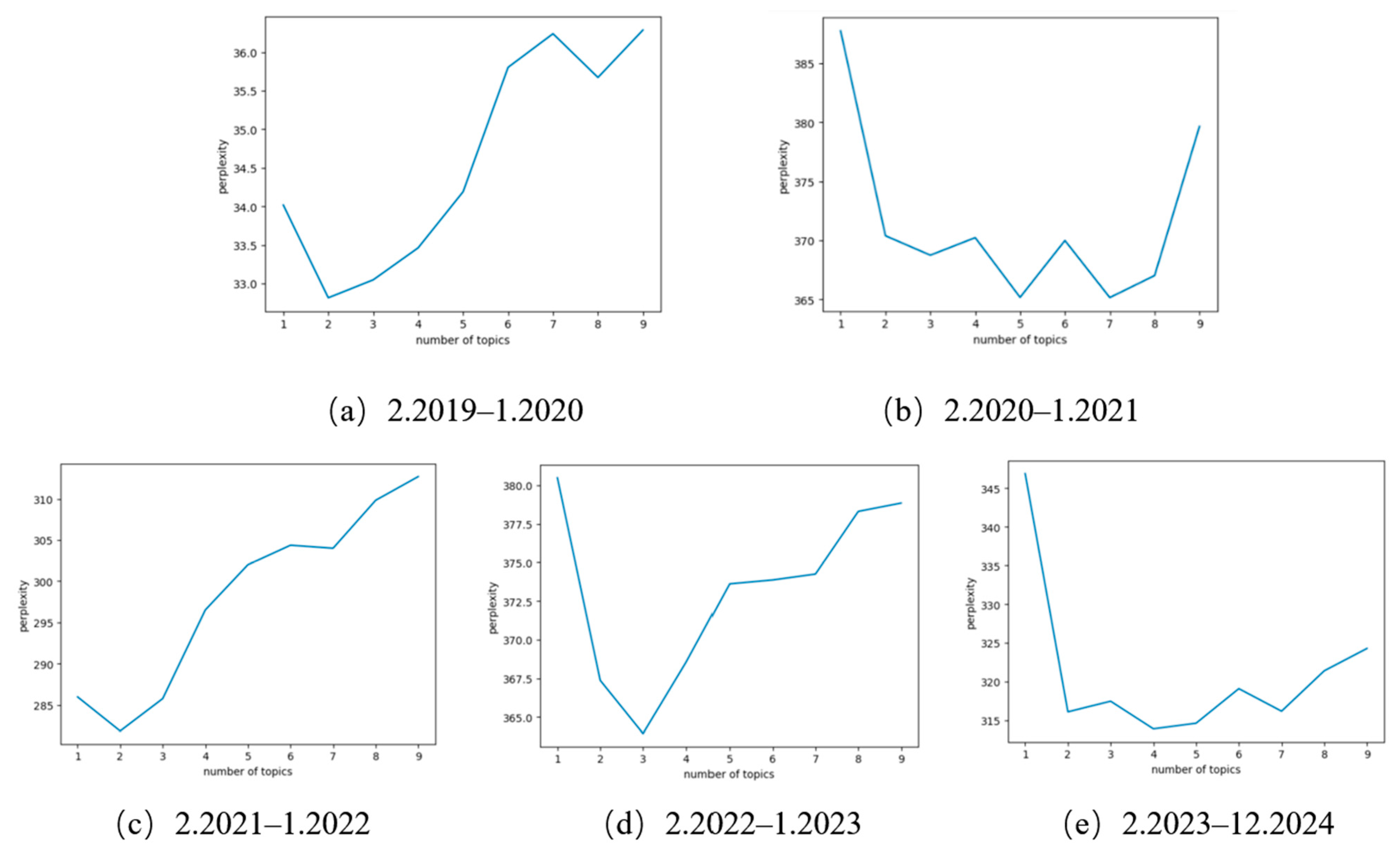
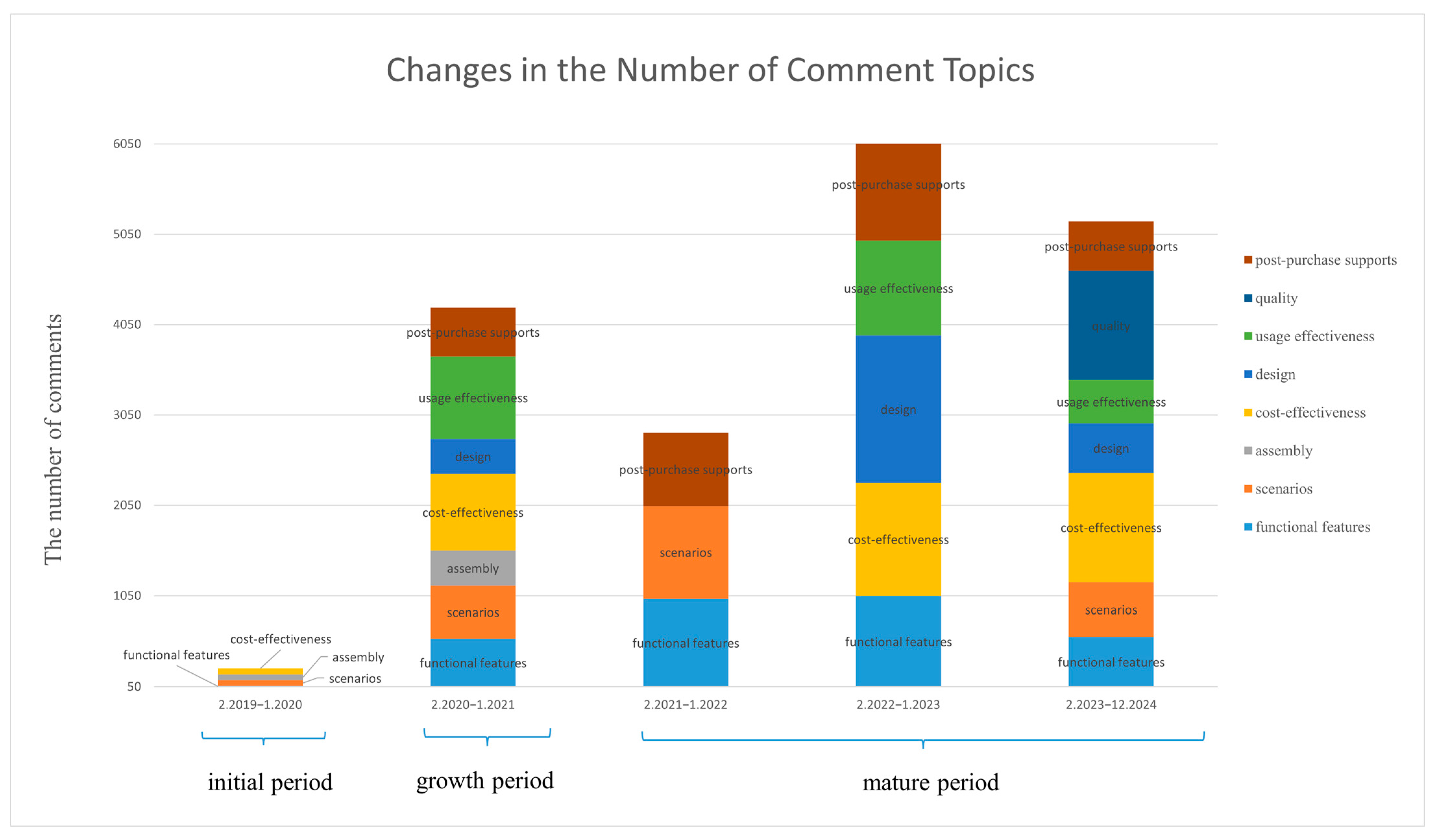
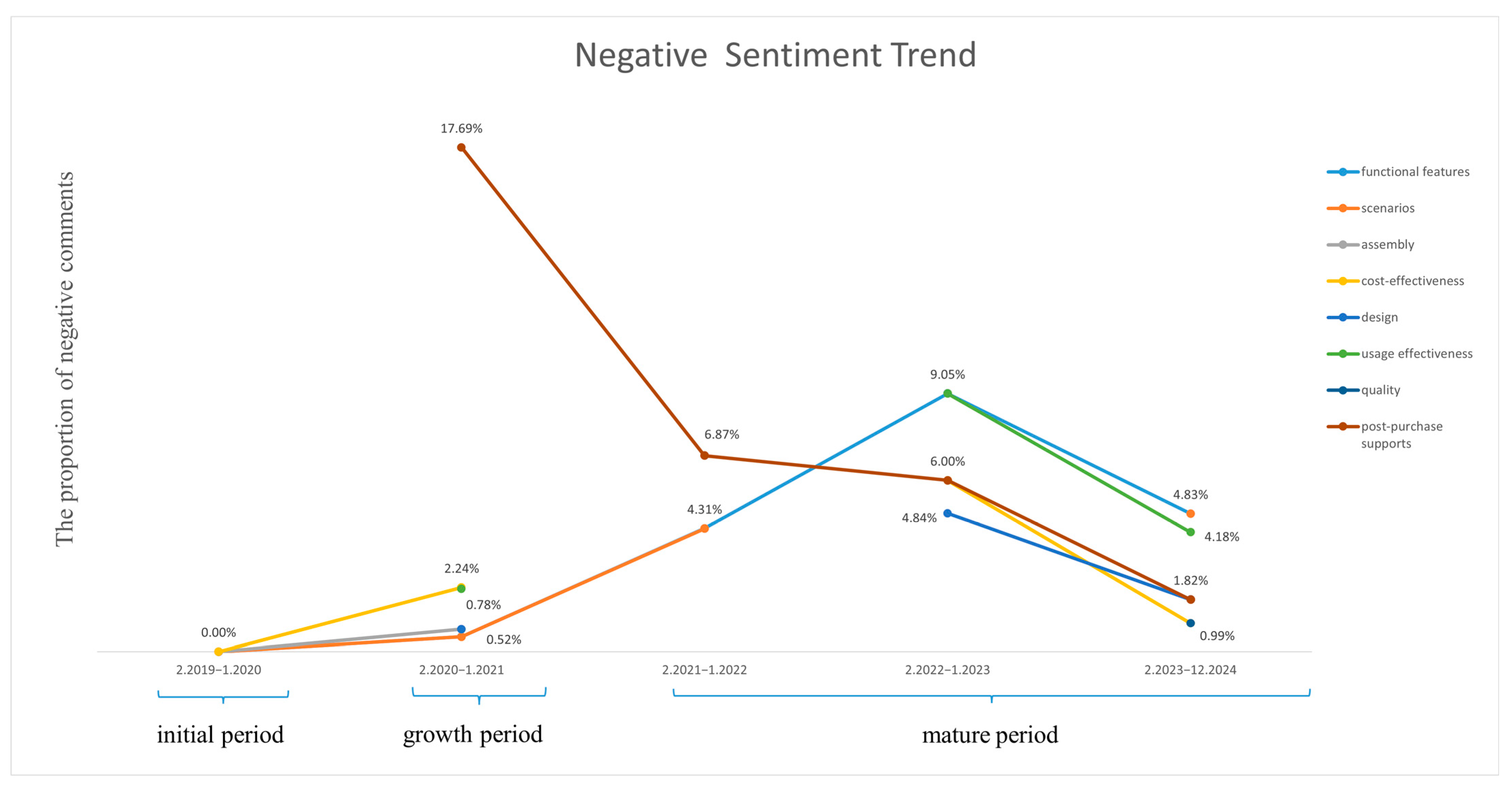
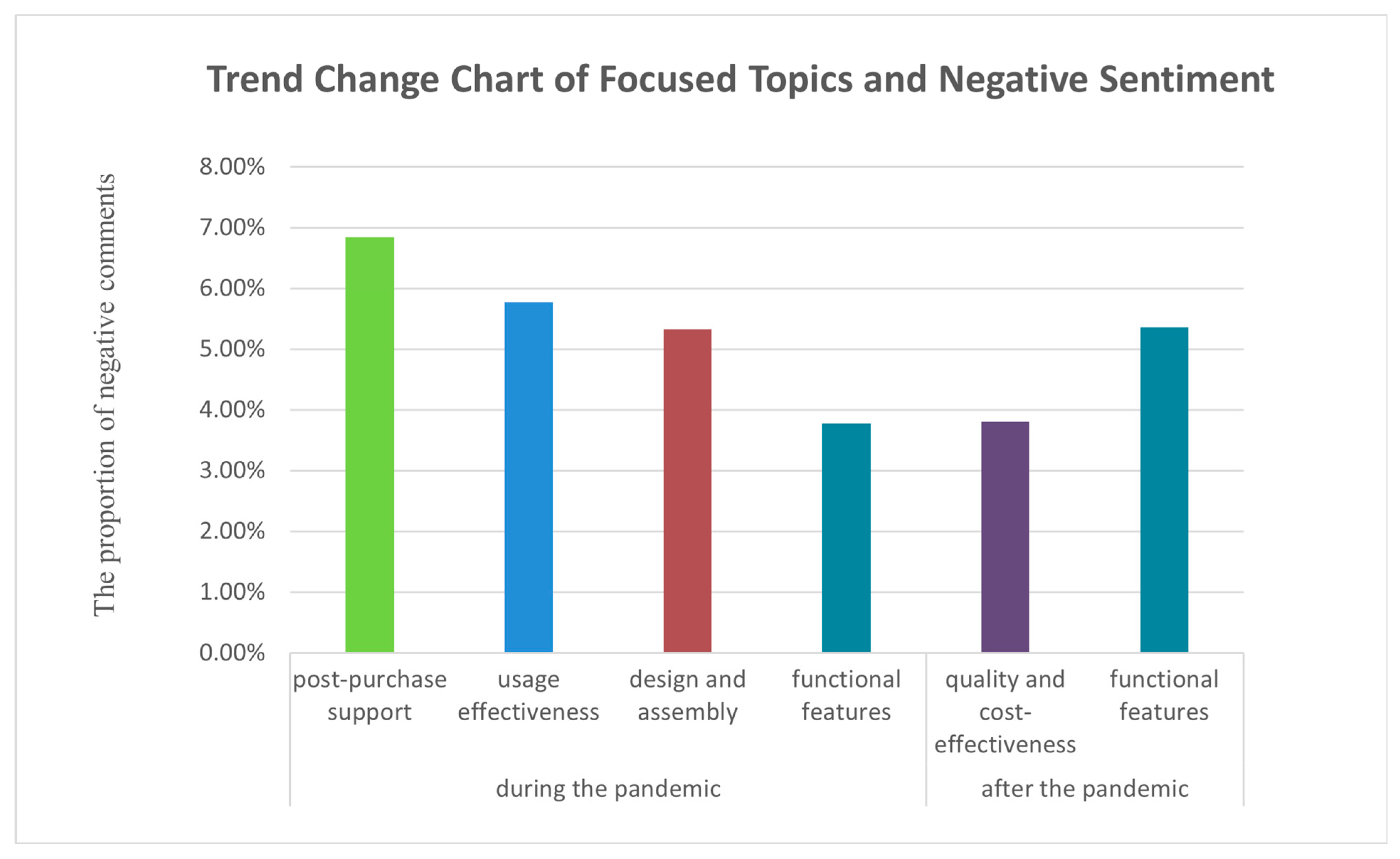
| Title | Date | Content | Rating |
|---|---|---|---|
| I made the right choice!! | 18 November 2023 | Unbelievable quality, and assembly was easier and quicker than expected. The desk far exceeds my expectations and is amazingly stable. Highly recommended!!! | 5 |
| Support is amazing | 16 November 2023 | Experience was so good that I bought a different product. Best part to me was support. | 5 |
| Bad Installation Process | 2 January 2024 | Table top and legs work and look good. Installation could be much better. Table top should have threaded inserts instead of tiny pilot holes. The pilot holes didn’t even line up correctly with the base. | 3 |
| Centrality Indicator | Top 10 Nodes by This Indicator |
|---|---|
| Degree centrality | beam, holes, height, instructions, drill, screws, width, received, lock, desktop |
| Closeness centrality | instructions, beam, holes, height, screws, desktop, couple, missing, table, legs |
| Betweenness centrality | holes, beam, height, instructions, received, desktop, screws, table, couple, service |
| Topic 1 | Topic 2 | Topic 3 | Topic 4 | Topic 5 | |||||
|---|---|---|---|---|---|---|---|---|---|
| topic word | weight | topic word | weight | topic word | weight | topic word | weight | topic word | weight |
| stand | 2395.03 | quality | 2082.25 | stand | 1090.64 | service | 1010.01 | monitor | 735.01 |
| height | 2037.83 | sturdy | 1593.39 | quality | 534.3 | customer | 995.01 | hole | 689.01 |
| sit | 1493.16 | assemble | 1471.97 | sit | 518.86 | delivery | 604.01 | cable | 578.01 |
| adjustable | 684.46 | price | 1236.13 | office | 331.49 | product | 587.35 | desktop | 541.15 |
| time | 557.97 | product | 1141.36 | workspace | 331.01 | ship | 420.19 | table | 532.14 |
| position | 528.74 | stand | 1018.74 | design | 329.65 | fast | 418.03 | drill | 524.01 |
| adjust | 472.01 | table | 831.13 | productivity | 327.01 | arrive | 324.21 | instruction | 523.62 |
| button | 357.54 | purchase | 782.56 | help | 257.17 | support | 261.6 | stand | 517.63 |
| pain | 335.01 | solid | 625.4 | game | 248.89 | damage | 253.83 | frame | 456.17 |
| adjustment | 326.94 | build | 580.65 | ergonomic | 232 | company | 238.66 | sturdy | 441.09 |
| office | 304.92 | assembly | 504.19 | changer | 204.01 | quick | 231.01 | assembly | 423.6 |
| space | 294.42 | instruction | 452.4 | stability | 196.22 | receive | 218.93 | heavy | 402.81 |
| feature | 289.12 | worth | 415.05 | standard | 188.24 | issue | 206.95 | set | 383.58 |
| smooth | 280.4 | office | 414.14 | focus | 186.01 | quality | 189.08 | screw | 368.01 |
| hour | 280.38 | money | 374.11 | posture | 181.22 | shipping | 181.01 | weight | 329.01 |
| feel | 272.21 | smooth | 363.12 | sleek | 174.45 | purchase | 173.58 | leg | 328.58 |
| memory | 260.89 | buy | 354.37 | feature | 171.9 | review | 173.41 | motor | 326.79 |
| set | 247.49 | frame | 345.99 | outstanding | 169.25 | experience | 156.67 | hold | 297.01 |
| change | 242.32 | expect | 338.13 | health | 164.43 | week | 130.09 | fit | 295.47 |
| switch | 241.69 | stable | 330.38 | comfort | 164.01 | star | 127.42 | solid | 293.94 |
| functional features | quality and cost-effectiveness | usage effectiveness | post-purchase support | design and assembly | |||||
| Parameter Name | Parameter Value |
|---|---|
| LSTM units | 128 |
| vector size | 100 |
| seq_len | 150 |
| activation function | sigmoid |
| loss function | binary_crossentropy |
| optimizer | adam |
| epochs | 10 |
| batch_size | 64 |
| metrics | accuracy |
| True Label | Predicted Label | |
|---|---|---|
| Negative | Positive | |
| Negative | 80 | 18 |
| Positive | 158 | 2143 |
| Accuracy | Precision | Recall | F-Measure | Duration | |
|---|---|---|---|---|---|
| LSTM | 0.9266 | 0.9917 | 0.9313 | 0.9605 | 242.671 s |
| Comment Topic | Number of Comments | Proportion of Negative Comments | Proportion of Positive Comments |
|---|---|---|---|
| quality and cost-effectiveness | 3863 | 1.97% | 98.03% |
| functional features | 2549 | 2.55% | 97.45% |
| design and assembly | 2750 | 5.49% | 94.51% |
| usage effectiveness | 1669 | 12.46% | 87.54% |
| post-purchase supports | 1166 | 10.38% | 89.62% |
| Time Period | Stage | Topics | Number of Comments | Negative | Positive |
|---|---|---|---|---|---|
| 2.2019–1.2020 | initial stage | functional features & scenarios | 62 | 0% | 100% |
| assembly & cost-effectiveness | 64 | 0% | 100% | ||
| 2.2020–1.2021 | growth stage | cost-effectiveness | 849 | 2.24% | 97.76% |
| assembly & design | 386 | 0.78% | 99.22% | ||
| functional features & scenarios | 582 | 0.52% | 99.48% | ||
| usage effectiveness | 915 | 2.19% | 97.81% | ||
| post-purchase supports | 537 | 17.69% | 82.31% | ||
| 2.2021–1.2022 | mature stage | functional features & scenarios | 1021 | 4.31% | 95.69% |
| post-purchase supports | 815 | 6.87% | 93.13% | ||
| 2.2022–1.2023 | cost-effectiveness & post-purchase supports | 1249 | 6.00% | 94.00% | |
| design | 1631 | 4.84% | 95.16% | ||
| functional features & usage effectiveness | 1050 | 9.05% | 90.95% | ||
| 2.2023–12.2024 | usage effectiveness | 479 | 4.18% | 95.82% | |
| quality & cost-effectiveness | 1208 | 0.99% | 99.01% | ||
| design & post-purchase supports | 548 | 1.82% | 98.18% | ||
| functional features & scenarios | 601 | 4.83% | 95.17% |
Disclaimer/Publisher’s Note: The statements, opinions and data contained in all publications are solely those of the individual author(s) and contributor(s) and not of MDPI and/or the editor(s). MDPI and/or the editor(s) disclaim responsibility for any injury to people or property resulting from any ideas, methods, instructions or products referred to in the content. |
© 2025 by the authors. Licensee MDPI, Basel, Switzerland. This article is an open access article distributed under the terms and conditions of the Creative Commons Attribution (CC BY) license (https://creativecommons.org/licenses/by/4.0/).
Share and Cite
Liu, C.; Chen, T.; Pu, Q.; Jin, Y. Text Mining for Consumers’ Sentiment Tendency and Strategies for Promoting Cross-Border E-Commerce Marketing Using Consumers’ Online Review Data. J. Theor. Appl. Electron. Commer. Res. 2025, 20, 125. https://doi.org/10.3390/jtaer20020125
Liu C, Chen T, Pu Q, Jin Y. Text Mining for Consumers’ Sentiment Tendency and Strategies for Promoting Cross-Border E-Commerce Marketing Using Consumers’ Online Review Data. Journal of Theoretical and Applied Electronic Commerce Research. 2025; 20(2):125. https://doi.org/10.3390/jtaer20020125
Chicago/Turabian StyleLiu, Changting, Tao Chen, Qiang Pu, and Ying Jin. 2025. "Text Mining for Consumers’ Sentiment Tendency and Strategies for Promoting Cross-Border E-Commerce Marketing Using Consumers’ Online Review Data" Journal of Theoretical and Applied Electronic Commerce Research 20, no. 2: 125. https://doi.org/10.3390/jtaer20020125
APA StyleLiu, C., Chen, T., Pu, Q., & Jin, Y. (2025). Text Mining for Consumers’ Sentiment Tendency and Strategies for Promoting Cross-Border E-Commerce Marketing Using Consumers’ Online Review Data. Journal of Theoretical and Applied Electronic Commerce Research, 20(2), 125. https://doi.org/10.3390/jtaer20020125






